Neil Koenig, ex BBC producer and current ideaXme board advisor and guest interviewer, interviews Mohammed Afkhami, philanthropist and art collector. If asked to name a country associated with modern art, few people today might think of Iran. The collector Mohammed Afkhami is working hard to change that perception.
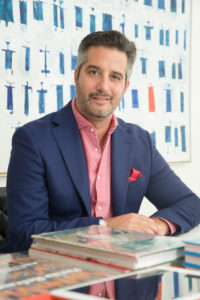
In recent years he has amassed a large collection of Iranian art. Mr Afkhami says his love of art began at an early age: “we used to visit my grandfather’s house multiple times a week, and he collected Islamic art and antiquities, Western artworks, Japanese lacquer…it was a fascinating and enchanting house of treasures”. He left Iran as a young child, after the revolution at the end of the 1970s. After embarking on a successful career in finance, he eventually returned in the early 2000s. “It felt like coming home” he explains. Mohammed Afkhami was surprised and delighted by the quality of contemporary art available, even though there were only a small number of galleries open at the time in Tehran. He bought works by Sirak Melkonian and Massoud Arabshahi for around $500 apiece. Since then, the collection has grown to include works by artists such as Shirin Neshat, Monir Farmanfarmaian, Parviz Tanavoli, Abbas Kiarostami and many more. What is the art scene like in Iran today? According to Mr Afkhami it is thriving, despite the impact of sanctions. There are now hundreds of galleries in Tehran, he says: “an artist is lucky to have a show that lasts longer than a month, because there’s such a backlog of artists wanting to exhibit”. In an interview with me for ideaXme, Mohammed Afkhami talks about his passion for his country’s art, how he built his collection and how he works with artists and galleries, and how art can serve to broaden understanding and break down cultural barriers.
Rebel Jester Mystic Poet Exhibition
“Rebel, Jester, Mystic, Poet: Contemporary Persians—The Mohammed Afkhami Collection”, can be seen at the Asia Society in New York until May 2022. Drawing from the collection of financier and philanthropist Mohammed Afkhami, the exhibition comprises paintings, sculptures, photographs, and videos.
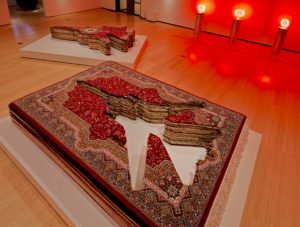
Of the 23 participating artists, over a third live in Iran, over a third live outside of Iran, and five live in New York City. These established, mid-career, and emerging artists are working from unique vantage points, informed by a rich cultural heritage as well as more recent extensive social and political unrest in Iran. Referencing “contemporary Persians,” the exhibition’s title evokes an ancient culture that is still very much alive today. The curator of the exhibition is Dr. Fereshteh Daftari.
A ideaXme is a global network – podcast on 12 platforms, 40 countries, mentor programme and creator series. More soon. Get involved: https://radioideaxme.com/get-involved/ Mission: Move the human story forward™
The ideaXme interview with Mohammed Afkhami
Neil Koenig: [00:00:00] We’re here to “idea” everyone, to fire up your curiosity and connect you with the people and ideas that shape our world. Watch. Listen. Understand. Connect. Create. Let’s move the human story forward together.
Neil Koenig: [00:00:19] Welcome to ideaXme. I’m Neil Koenig. Think of the country Iran today and modern art might not be the first thing that comes to mind. One collector who’s trying to change that perception isMohammed Afkhami, who’s built up a large collection of Iranian art in recent years. You can see some works from his collection in the show Rebel, Jester, Mystic, Poet on display at the Asia Society in New York until May 20, 2022. Mohammed, thanks for joining us. Before we talk about the exhibition, just tell us a little bit about yourself and your background.
The Mohammed Afkhami Collection
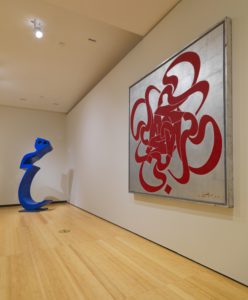
Mohammed Afkhami: [00:01:01] Thanks, Neil, and thanks for giving me a few minutes to talk about the collection and what I’m trying to achieve. I’m of Iranian origin, but I consider myself an Anglicized Iranian because I left Iran during the revolution at the age of four, in 1979, and pretty much spent my formative years in the UK and Switzerland. So, I consider the UK as my adopted home with London being the base. And then I went to study in the States and then I worked in a series of financial services firms until I set up my own. Starting in Chicago, then New York and London. And for the last 20 years I have been based in Dubai. And it’s actually been a great journey because I think that my life has done a full loop in that I started in the Middle East, and I ended up back in the Middle East. And Dubai is the perfect combination because I still feel a strong sense of Iranian identity. But given what I do for a living and where I sit, unfortunately the opportunities that are present for me are not in Iran. They exist in the Middle East and London and New York. Yet Dubai gives me that sense of being close to home because there’s such a strong Iranian influence and a lot of Iranian expatriates are here. I’ve had Dubai as my second home now for the past 20 years. And in that time, since the early days of when I moved there in 2004, I started reconnecting with Iran, but more on a cultural basis by beginning to collect art from that country.
Mohammed Afkhami: [00:02:45] And so this had been a 16/17-year project and it continues. [00:02:52] But it was a project that was designated by accident. I come from a family that has been very involved in the process of art collecting and of art philanthropy from the sixties where my grandfather had a very large collection of Islamic art and antiquities that my mother helped him amass. I’ve always been surrounded by art from Iran, albeit from a different period. And I’ve also had the privilege of knowing some of the great academics that covered Iranian and Islamic art history growing up. It was an accidental passion that stumbled into my life when I was visiting family in Iran in 2004.
Mohammed Afkhami: [00:03:34] I had to spend a little longer there than I’d hoped. I had to renew some paperwork and I was introduced to a few contemporary galleries. At the time there were less than a handful and I saw some beautiful artworks and of course I wasn’t familiar with Iranian currency. Unfortunately, Iranian currency has a lot of zeros. I asked the galleries, I said, you know, (this Mah gallery in central Tehran): How much is it worth? They said 50,000. So, I thought, I’ve got to work a lot harder to buy that work. It was in fact 50,000 Riyals at the time. It equated to something like $500. And so, I bought my first two pieces of art.
Neil Koenig: [00:04:14] And what were these artworks?
Mohammed Afkhami: [00:04:17] These were actually by two great modern masters of Iranian art, very recognized, published, museum exhibited. One is a gentleman called Sirak Melkonian, who is an Iranian Armenian, and the other one was a guy called Massoud Arabshahi. Both, as I said, very talented and recognized modern masters. And one work was very minimalist. It almost looks Japanese. It’s very clean, almost refined looking art. And the other one was by Massoud, and that almost had a feeling of like an engineering schematic, but with abstraction overlaid over it. And again, both works were beautiful, and I thought that I was very lucky to buy them for $500 each. And of course, when I bought these works, I started buying more because it was so affordable, and I just bought my first home in Dubai, and I therefore had a lot of wall space. So, I said, I’ve got to go to buy art to populate this home. And then, of course, this passion stepped in, and I was telling my mother about it, and she was not convinced. I mean, she knew many of these modern artists, but she was more an advocate of more traditional Islamic art and antiquities.
Iranian Art

Parsec #15, (left) 2009. With permission: Mohammed Afkhami Foundation.
Mohammed Afkhami: [00:05:30] But then as I showed her some of the works, you know, her knowledge and her connections within Iran and with the actual artists proved invaluable because she caught the bug. And we really built this collection together. And today the collection has just over 600 works. About 480 to 500 are from Iranian artists, but not just Iranian artists from the modern and contemporary period in Iran. We collect artists that are Iranian origin that might have never even been to Iran. And about 100 of the 600 works are really contemporary and modern artists from around the world because there’s also an aesthetic override on the collection where of course we love to support Iranian artists, but on occasion you see a work that’s just fabulous. And just because it’s not Iranian doesn’t mean it should be disqualified. So, we have, again, you know, a host of these works that are not from Iran but keep the same strain of aesthetic appeal if you like of the overall collection.
Neil Koenig: [00:06:34] Let’s go back to your upbringing, your childhood. Your grandfather had a large collection of Iranian art and artworks. What kind of impression do you remember that having on you when you were growing up?
Mohammed Afkhami: [00:06:51] Well, you know, it’s funny you ask that question, because as I told you, I left Iran when I was four. But some of the first memories that I have that are quite vivid and quite clear are that we used to visit my grandfather’s house multiple times a week, and it was really quite a treasure trove because yes, he collected Islamic art and antiquities, but his house was like this fascinating and enchanting house of treasure, all kinds of art, and even had Western artworks, all sorts of things, you know, Japanese lacquers. I remember if you walked around and touched something, you might cause damage. It was a very vivid memory because he really loved his art and lived with it and was, you know, incredibly knowledgeable. And then, of course, when the revolution happened, unfortunately, this collection was largely nationalized. But when we grew up in London, you know, we had kept very close contacts with some of the scholars that are archiving my grandfather’s collection. So, these scholars were regularly in our house and my mother would have these small dinners, always cooking homemade Persian meals that they would all come in for. And we would talk about the art. And my mother decided to formalize her training in the early eighties and went back and pursued an MPhil, at SOAS, the School of Oriental African Studies at the University of London focusing on a specific period of Qajar art, which is late 1700s, early 1800s. And so, there were always some objects in the house, and the house built on its Iranian identity through these artworks that she collected as a result of new collecting later after the revolution.
Neil Koenig: [00:08:33] Iran has a very long history. What impact does that have on artists working today?
Mohammed Afkhami: [00:08:40] You know, when people talk about Iran, I don’t like to think about Iran and the Iranian art as any defined boundary. Iran is an idea, and it’s very interesting to ask that question because when you see the way contemporary artists make art, it’s amazing to me how they keep drawing from influences in their Iranian identity. Either they’re depicting imagery that might be somewhat calligraphic in nature, or it might be depicting a scene that they’re imagining from the Shahnameh, which is, you know, our Book of Kings, which is the equivalent of Homer’s Iliad for Iranians. Or they’re drawing on the Achaemenid glory days when the Persian Empire was at its maximum in terms of size and global influence. It’s just interesting how these themes just keep coming back again and again, even some artists that choose to pick up very strong Shia motifs. I mean, the influences are everywhere. And then, of course, very interestingly, they take this influence and then they adopt it in terms of their technique and to make it appealing to an audience that would like it today. Because if you think about my parents’ generation, they were happy to buy manuscripts and calligraphy. If you talk to people my age and younger, they want big paintings with more abstract features, yet they’re happy to see elements of calligraphy incorporated, but not in the same detailed, almost academic way you see in a traditional Islamic manuscript. Yet the artist does not dump that notion of the past. They’re still incorporating it, but they’re adapting to their audience. There’s this constant dance between the past and what these artists are making today.
Neil Koenig: [00:10:34] You left Iran around the time of the revolution, at the end of the 1970s, and then you returned, and that’s when you began your journey of exploration of art in Iran. What was the scene like when you went back?
Mohammed Afkhami: [00:10:55] That’s a great question. I didn’t set foot in Iran from late 78 until 2002. At the time, I had been recently appointed the head of a regional arm, a South African bank called Standard Bank. My region was obviously the Middle East and North Africa, and we had a small satellite office in Tehran that came under my remit. I flew there to check on it. It was the first time that I had been back in 24 years. I’m not a very nervous individual and I don’t get that, you know, clammy hands when the situation gets, you know, a little tense. But I remember I was flying on Emirates, and they were flying at an interesting altitude, low enough that I could see the tops of the Zagros Mountains. We were flying north through the Gulf, Tehran. And I was getting nervous. When I got off the plane, it was very interesting. It’s almost like I knew that I came from this land. Like as soon as I got off the plane, I smelt the air and there was a gentleman who greeted me at the bottom of the plane. It was as if I’d come back home. It was very interesting, and I can’t explain it. I know it sounds preposterous, but it is a very eerie feeling when, you come from somewhere and you didn’t realize it until you did. And it was like that. And it was actually somewhat endearing, you know, despite the fact that the country, you know, is not in the best of states, I felt a certain warmth. I felt good about being back. I enjoyed it. I enjoyed the interaction with the people. I enjoyed going down from my mother’s apartment to the local bakery and just exchanging a few words with the bakery. And it’s giving me this huge freshly made slice of Iranian Barbary bread and just eating it on the way home. I mean, these simple pleasures and feelings are, something you feel when you come back to somewhere where you’re from.
Neil Koenig: [00:12:53] And what was the art scene like at the time?
Mohammed Afkhami: [00:12:58] So at that time I didn’t even know about the art scene. I mean, there were literally in the early 2000s, maybe five or six galleries. Today, they’re well over 120/130. And it’s become such a such a thriving scene that imagine this meal. Imagine that today an artist is lucky to have a show that lasts longer than a month because there’s such a backlog of artists that want to exhibit and be exhibited that They’re just coming out of the woodwork. And Friday afternoons have become almost like a weekly event where collectors get together and then just promenade through the streets of Tehran from gallery to gallery, effectively gallery hopping. And it’s like an activity that people really look forward to. So, I would tell you that, you know, the scene is thriving there. There was a group of ex Iranians who worked for Christie’s Dubai, learned exactly how Christie’s does a proper auction. And I would tell you that they’ve set up an auction there called the Tehran Auction. The catalogues look and feel like a Christie’s catalogue. And when you go to the auction room, of course, imagine a very elegant auction setting. But imagine adding an overlay of Persian hospitality where you’re sitting down and people in white gloves are serving you little horsˈ d’oeuvres and aperitifs, while you’re in the auction bidding. So, it’s quite interesting to see how they’ve adapted to their own scene. And, of course, recognising that movement of capital between Iran and outside is very difficult. So, they’ve created their own domestic scene that doesn’t need any support from abroad and doesn’t need to be sent abroad either. It’s internalized.
The Thriving Art Scene In Iran
Neil Koenig: [00:14:51] A lot of people may be surprised by the idea of a thriving art scene in Iran. One imagines political pressure or censorship. I mean, are those things an issue at all?
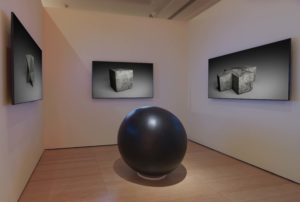
Becoming, 2015 (foreground). With permission: Mohammed Afkhami Foundation.
Mohammed Afkhami: [00:15:06] I think there are probably red lines you don’t want to cross in Iran. And I suppose if you’re not a sanctioned political entity, that would be a difficult position for someone to be in. But when it comes to the art scene, I would tell you that largely speaking, the government, have a very hands-off approach. And I’ve rarely heard of any meaningful censorship of Iranian art. You know, of course, there are examples, but very little by way of true censorship. I would say at least by not doing anything, they’re implicitly supportive of it. And you can actually see that because even when you see Iran’s government, showcase themselves in international affairs or exhibitions, I can just tell you what you see. If you go to the expo in Dubai and you go to the Iranian pavilion. 80% of the content is about Iran’s culture and history. And so, if you contrast that with other regimes that have an Islamic undertone, there is no promotion of culture. I mean, take the Taliban on the extreme end. They deliberately set about destroying old culture and just carpet bombing anything that has a legacy to Afghanistan’s past. The Iranian government, I would say, is not in that camp by any stretch. And as I said, they’re happy to promote their culture because it’s a win for them as well.
Neil Koenig: [00:16:43] What’s the situation with education and training for artists and craftspeople?
Mohammed Afkhami: [00:16:49] So I would say, the Iranian government is under pressure financially and I would say there is not a huge budget for any open support. But of course, there are plenty of art schools in Iran. At university, you can study art history. You can study making of art. And there are thriving schools that are available for those people who want to pursue that line of career. They’re at least doing the minimum to preserve, you know, historical sites. Also, we have this Tehran Museum of Contemporary Art. And in the last ten years, there have been several seminal shows where they’ve extracted some of those works and showed them on display. I went to this wonderful show in 2013 where, they brought in Germano Celant, the famous curator who sadly passed away last year from COVID. But he came and did a wonderful show where he got carte blanche to take pride in his works and contrast them with, masters from this incredible Western archive that the Iranian government owned. And it was quite interesting to see all these grandees from the global art scene descend on Tehran for this this opening. So, I would say they do what they can, but of course, they don’t have the means of some of their neighbours in the Gulf that, are really making huge strides ahead with these very large initiatives, whether it’s the Guggenheim or the Louvre or the Qatar Museum of Islamic Art.
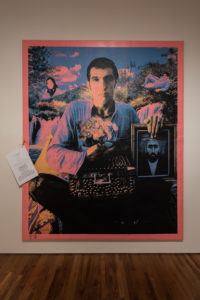
Mohammed Afkhami: [00:18:21] I mean, they don’t have such funding, but I think they recognize that art, especially a country like Iran that has so much embedded art history, it is a form of soft power. And it’s a good use of power because at the end of the day, we live in an age where, unfortunately, across any political society, whether it’s in the UK, the US, anywhere, people are divided. But divide it in a way where we probably haven’t seen such extreme divisions. But when it comes to like culture, that’s something where people can agree on like you and I might not agree you and I might not agree on whether you should be a Tory or Labour supporter, but we can both agree that a piece of art looks good or, you know, has some meaning to you and me. Right? So, I think it’s a very interesting way to bridge differences and also lower or soften the tone.
Neil Koenig: [00:19:17] Art can serve as a kind of bridge to the rest of the world.
Mohammed Afkhami: [00:19:21] I think so. And that’s one of the reasons why I’m so passionate about Iranian art, because I deal with a lot of Americans, I deal with a lot of Europeans. And, when I say that I am from Iran, I can see some that are, let’s say, less aware of what Iran is. They’re like, ooh and regard you with a touch of suspicion. Of course, it’s momentary, but you can pick it up immediately from facial or body language. So, I thought to myself, wouldn’t it be great if people saw an alternative narrative to Iran? And really the greatest asset of Iran is its culture. I mean, forget about oil and what goes on in contemporary Middle Eastern politics today. Every nation has its ups and downs, but Iran’s cultural contribution to the world is unquestionable. And I think that anything that promotes that and shows a different light is something I’m for, because at the end of the day, I am very grateful to being English, that is having an English passport. If I were required to fight for love and country, I would fight for England in a heartbeat. But at the same time, I can’t deny my ethnic roots either. And so, it upsets me to see the country portrayed in such a way, because I know the people to be, very different to the way the Western caricature is of that country. And at the same time, I think that if people only knew how much Iran as a country has contributed to things that we use daily, that we recite daily, that we visually enjoy daily, I think it would change the tone towards Iran.
Neil Koenig: [00:21:06] Listening to you talk about your love of your country and its heritage, it makes me wonder whether you have perhaps a slightly different goal from other people who might collect art.
Mohammed Afkhami: [00:21:23] It’s like an onion. There’s like multiple layers of why. So, for me, I do it because I think it’s important to have another narrative. But I would say at a more granular level, you know, there’s a huge artistic scene in Iran that doesn’t have much financial support from the state because the state just doesn’t have the means. It’s this country that’s been under sanctions in one form or another for 42 years. And so, buying Iranian art helps Iranian artists. The best way you can help Iranian artists is simply to buy their works at a very simplistic level. So, if I am able to show great international or great Iranian art to the international world, where there’s frankly a ton of money and a ton of interest for new ideas, new works. And they decide to buy Iranian art. Then I’m doing my job. And I think that in some way, bringing Iranian art to an international audience has already achieved certain goals. When I started collecting maybe a handful or two handfuls of Iranian artists globally were represented by major art galleries. Today, there are at least 40, 50 artists that are represented by major international galleries. And those galleries are not selling to Iranian audiences. They’re selling to global audiences. So, you’re seeing these Iranian artists now sit in collections that they couldn’t possibly imagine being in 10 or 15 years ago, because there is an interest. There is the talent. And then, of course, over the years you have to think about how to make this art scene more sustainable. Because tomorrow I could have this call with you and then cross the street and be run over.
Mohammed Afkhami: [00:23:09] And that’s the end of my contribution, at least in terms of being active and able to promote. But what will certainly have a more durable or sustainable effect on Iranian and Middle Eastern art scene are these Middle Eastern and North Africa acquisition committees that have been set up by many prominent museums, including LACMA, Guggenheim, British Museum, Tate, just to name but a few. All these different groups have pulled together people who have an interest in Middle Eastern art and raised funds to buy works that now form part of the permanent collection of each of those respective institutions. And so that is important. And of course, you’ve seen those works already on display like LACMA had a show a couple of years ago where they took a lot of their own work, plus invited collectors to lend. The British Museum had a wonderful show that ended this past September that was curated by Venetia Porter, who is the head of the Islamic Department called Reflections. And that was entirely based on the collection that we’ve amassed that’s over 300 works from the British Museum’s Middle East and North Africa Acquisition Committee. So, these are important drivers for Iranian artists to sustain themselves. Even more than, let’s say, a multibillionaire setting up a museum and having a great splash and an opening. No one’s thinking about what that museum will look like and feel like in ten, 20 years. While I’m pretty certain that the British Museum will be around for the foreseeable future.
Neil Koenig: [00:24:47] Yeah. How do you go about working with artists? Do you just buy things at auction, or do you commission and help artists to develop their work?
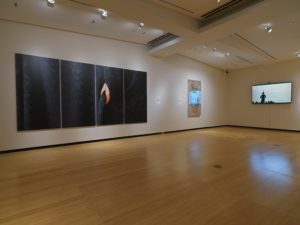
Mohammed Afkhami: [00:25:03] It’s a bit of everything. I mean, first things first. I think that there is a trajectory that an artist should pursue to, again, manage their own career. I think it’s very important for an artist to work with a gallerist who will then work to get the works placed in different collections. And then if the artists are talented enough, start placing those works with museums or start encouraging some sort of museum show or group show participation. So, we buy a lot from galleries. We buy a lot from auction. If we see things that are, let’s say, very rare or difficult to procure any other way and they happen to appear in auction, we come in and just try to go for it. We also buy from secondary dealers or families that happen to have fantastic works in their own archive. And then there’s a generational transition. People know that we’re always in the market and they’ll call us. You know, we also have artists that do commissions, as you say, when they try an experimental work and say they want to make something from a Carrara marble piece, and you’ve got to spend money to make it in the fabrication. Then you enter into an arrangement where you help fund them and you don’t look for return. You just look for like, let’s say, a decent entry price for that work so long as they can make more, and then other buyers come in. So, there are those sorts of arrangements as well. So, this is how we do it, this is how we source the work and how we help the artists either directly or through galleries or support them in auction. It depends.
Neil Koenig: [00:26:41] And you mentioned the sanctions which have been going on for many years. How much of a practical problem, how much of a barrier do they present?
Mohammed Afkhami: [00:26:51] It’s a problem because if you’re buying works in Iran, you need to have funds in Iran. Now, luckily, I have some funds that are in Iran that I use to pay for my bills there. But sending money into Iran is very difficult because you just can’t transfer money internationally because Swift is not accessible for them. It’s not an option. So that’s why, in a way, there’s a bifurcated scene that’s developed where people who are in Iran that collect within Iran, you know, they just keep everything in Iran. So, they’re earning in Iran. They’re spending in Iran. They keep the works. Iran transporting works is not such a problem, although your choice of shippers and your choice of transport is limited. So, there’s always a bottleneck because there’s a lot of work that wants to go out of Iran, but there’s only one or two credible shippers. So, logistics is a problem. But they find a way. I mean, you know, if you need to take money into Iran, there are these hawala dealers that, you know, they have a brother in Iran. The brothers outside give money to one. He gives you credit, another old school, Rothschild banking. And so, you can do it. But the reality is that we never had an issue because whilst we source a lot of work when we were amassing the collection in the early to mid 2000, you know, financial transfers, were not as strict as today. And then the reality is a lot of the work that we source today is out of Iran. So, it’s not really a practical problem for me, but it is a practical problem for people who are trying to develop a collection in Iran and then bring it out. Because, as I said, transporting the work is not easy and getting money into Iran is not easy.
The Asia Society
Neil Koenig: [00:28:33] Tell us about the exhibition, the show that currently on at the Asia Society, which has this intriguing title, Rebel, Jester, Mystic, Poet. How did the title come about?
Mohammed Afkhami: [00:28:48] I have to give 100% credit to our curator, Dr Fereshteh Daftari who is an excellent curator, highly accomplished in the field, not only recognized in Western circles, but obviously from a great Iranian family and deeply knowledgeable about Iran and the artists that she’s picked. You know, to her credit, she spent 18 months putting together this collection by trawling through the collection, seeing the works in person, talking to artists. And, when I asked her about how she thought of the title, she said it just came to her. She said there were elements of each word that she found to be relevant for this collection. So, this is a show that has 27 artworks, 23 different artists, 9 that are exclusively based in Iran, 9 that are based between Iran and somewhere outside, and 5 that are exclusively based outside of Iran. And each of these words, she’s found artworks with these artists that represent rebels. So, there’s certain works that that say, you know, are mildly critical of the system in Iran, jester where there’s some that are playful and mocking situations that are let’s say known to Iranians mistics, some works literally have a draw Sufi influence and poet, this is a homage if you like, to Iran’s rich poetry, but also its tradition of calligraphy. So, you have a sampling of each of these works that actually form a very interesting story as you walk around the show.
Mohammed Afkhami: [00:30:27] As I said, I’ve never met somebody that walked out of the show and said, God, I hate that show. That’s terrible. But it’s just had fantastic feedback from every visitor. But I do think, you know, it’s important that before you see the show, you try to go online and watch some of the curated tours and do a little homework because obviously, you know, each story, each work has a very rich story to it. And the selection of works that the curator has put together is fantastic because on the one hand, she’s picked some of the most established artists like Shirin Neshat, Monir Farmanfarmaian, Parviz Tanavoli and Abbas Kiarostami, the late filmmaker. These are all brand names in the art world. And then on the other hand, she’s found artists like Hamad Sahihi, Morteza Ahmadvand, that don’t even, you know, literally had no representation and are emerging artists. And she juxtaposed them all together in this wonderful show that really gives you a fantastic snapshot of the diversity of Iranian art, because the mediums themselves are diverse. You’ve got works in the form of an oil drum. You’ve got neon, you’ve got carpets, you’ve got a special plastic cut-out out, photos, mirrors, ceramic.
Mohammed Afkhami: [00:31:56] It’s quite impressive how many different ways you can make art. And so, she’s also showing you the breadth and range of these artists’ work. But interesting, to your earlier point in the conversation so many link back to Iran in one way or another. There’s always some reference to Iran and there might be something very political or contemporary, but it might be something as abstract as Iran’s history with Sufism. I mean, it depends on what work you’re looking at. I know that it’s very hard for people to fathom going around museums in the way we did before COVID hit. But this is a wonderfully curated show. It’s not a crowded museum. It’s a gem of a museum. Luckily for us actually, because there were so many cancellations and movements and people, you know, deferring shows, we ended up taking up the whole museum. So, the works actually have more space between them, and it really lends well to a visit. And so, I would encourage people to see it if they’re in New York and it’s going on until May, as you said, because nothing is better than seeing artwork in person, as you know.
Neil Koenig: [00:33:15] One thing that struck me going round the exhibition was the contrast and variety of the different pieces. I mean, there was a stack of carpets with a jet fighter cut out of them. And then there was the richly decorated oil drum, which also had bullet holes in it. And this kind of theme of war did seem to kind of pervade some of the pieces. But in other places in the exhibition, there was no sense of that. So, it’s quite a rich mix.
Mohammed Afkhami: [00:33:56] That’s right. I mean, like you brought it up brilliantly. I mean, you have some works that clearly characterized Iran in the post 1979 setting. Right. If you think about Iran, it’s basically been in one form of war or another since the revolution. And you know, you take the work you reference flying carpet by Farhad Moshiri. These are 32 machine made carpets, which also is like multiple meanings here. Like on the one hand, when you think about carpets, you think of Aladdin and the flying carpet, you have this sort of 1001 Arabian Nights notion of a carpet, but also a carpet is a traditional industry in Iran where, any weaver could take a year or more to make a single carpet. And of course, that industry is being decimated by the fact that today you have industrial processes that can recreate these carpets, albeit machine made. They don’t have the same texture or value. But at the same time, if you think about buyers of carpets, 95% of them are just in for the aesthetic. And if they can buy a carpet for 1000 versus 10,000, that’s man made. They’re going to buy the cheaper one. And so, as a subtle criticism of this carpet industry that’s in almost terminal decline because of the advent of modern technology and industrial processes.
Mohammed Afkhami: [00:35:21] But at the same time, it’s also critique about the fact that, here’s a society that we used to, at one point have. You know, carpet making is a magical, almost clichéd feeling of being in the souk. And now, the Middle East, Iran, this region has become very militarized. Same thing with the work that you described in the oil drum. This is done by a wonderful female Iranian artist based in California called Shiva Ahmadi. She’s taken the old school art of miniature, made this elaborate work across the barrel. But as you said rightly, with violent scenes and bullet holes that have been painted because why she’s basically saying that, with the advent of oil, our traditions have been compromised and the society has become, at least from an external perspective, a lot more violent because of, oil and the realities of oil politics. And then on the other hand, as you said rightly, that the other works in the show that have nothing to do with that and are very mystic in nature.
Mohammed Afkhami: You’ve got Y. Z. Kami’s domes, where you look at it and it’s almost hallucinogenic. You look at it and you’re like: Wow! It’s soothing. It’s peaceful. When you look at Shirazeh Houshiary’s Pupa, where you see this glass, you know, spiralling structure, that is basically the beginning of an Infinity column. A reference to her love of Sufism and this notion of infinity. And you think of a whirling dervish going round and round. Then you have Alireza Diame Dayani, where you see the six days of creation, where it’s the seeds and you see this mad almost psychedelic work where it’s four metres or maybe longer, four and a half metres long by one and a half wide or two metres wide where you see this entire work done in felt tip pen of this almost surreal creation of the seeds. Again, what is that got to do with Iran? It’s just this guy’s view of how the world was created. So, it’s very random. It’s very diverse. It’s very rich. And it shows you that you can’t pigeonhole Iranian art into any one area.
Neil Koenig: [00:37:41] What’s next for you? I understand that you’re thinking about setting up a kind of digital museum.
Mohammed Afkhami: [00:37:49] So that’s something that we’re working hard on. It’s really over a year in the making. We’ve had a few false starts because the technology is quite a challenge. But I have assembled a team which is drawn from New York, L.A., Tunisia, Iran, Paris. It includes some of the top groups in creating video, 3D designs. I’ve got a leading architectural firm of Rem Koolhaas and Herzog & de Meuron architects that have created a structure that could only exist in the virtual world. So, we’re really trying to put something together that would be clearly influenced from our part of the world. The idea is that it’s going to be a virtual archive for anybody to access and which is free to the public. And, if you want to know about Iranian artworks, you’re going to be able to, at least on a website feature, look up any work in the collection, and there will be a blurb about the artist. Obviously, it will be maintained to make sure that all their accomplishments and shows are updated in their in their biographies. And then there’ll be a visual rendering where we will bring the entire collection online in one shot. We will bring the archive in one shot. But the actual first rendition of this virtual museum will be focused on the architectural story and a new selection of works that probably be 30 to 40 works with a possibility of seeing the rest of the works, albeit at a distance.
Mohammed Afkhami: [00:39:26] And I know it sounds a little vague, but I don’t want to be too specific because it’s still not yet finished. And I want to leave an element of surprise. But the idea is that it’s going to be a new way to look at art. It’s going to be taking these artworks and doing things you could never do in a world with gravity, I’ll say that. So that way you can understand that we’re going to play with the fact that you’re going to have works suspended. And I think it’s going to be a nice way for people to see the work because, you know, it seems to me that these pandemics are going to become a new reality of life as we have new variants. And, sadly, not everyone has the opportunity to see some of these works in person. So, it’s great to at least have some way to deliver these works, at least in an online setting, while continuing to try to do a work or show every year or two in a new location and keep this roadshow going. That’s my idea. So, it’s a combination of bricks and clicks if you like.
Neil Koenig: [00:40:32] Is the goal to also make it easier for audiences in Iran to see some of the works in your collection?
Mohammed Afkhami: [00:40:40] Absolutely. So, on the technology, I’ve made it very clear that it has to be available in a way where understanding the bandwidth and the cable restrictions and broadband restrictions you have in Iran, I don’t mean by way of filter, I mean just the speed of their network is a lot slower than what you would find let’s say in Korea. It can be a show that that only Koreans can access. It’s got to be accessible at different levels to people who have different speed, access to the Internet. So, the answer is absolutely, this is as much for people in Iran as it is for people outside.
Neil Koenig: [00:41:22] What would be your advice to others who might want to do the same sort of thing for countries where they may not be perhaps known as widely on the international scene for art as they would like? How would you suggest that people follow your example?
Mohammed Afkhami: [00:41:43] I would say, every way you can promote art counts. I mean, I’m lucky that I’ve stumbled into a network of people who’ve made ideas happen. I happen to know people in the museum community and I’m friends with a lot of gallerists and dealers and they’ve all been supportive because I think they recognize that there’s really nothing to gain here other than increase Iran’s art exposure. So, people are always happy to help. And I think if you can cultivate your own network and promote things, you know, in any capacity, it’s worth it. And today the possibilities are endless. When I started doing this, the world of, let’s say, online social media was not the force it is today. And as you can see, people can be from nowhere and build an incredible online presence. And so that could easily be translated for art, too. And you don’t have to have actually don’t have to have money to do that. You just have to be clever. And so, I would be very supportive of it. I would tell them, you know, like, don’t be shy to ask favours, don’t be shy to send proposals because the worst thing someone can say is, no, they’re not going to say no, drop dead I wish you never contacted me. It’s just going to be a no. Or, sorry, I can’t help. You’ll be surprised by the extent to which people are looking for new ideas. There’s so much art in the world.
Promoting Misunderstood Culture
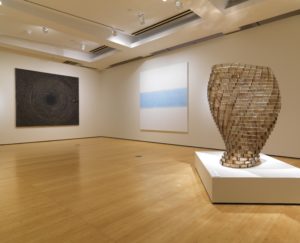
Mohammed Afkhami: [00:43:07] It’s funny, I think about some seminal moments when they opened the Louvre in Abu Dhabi, the whole idea was about tolerance. And interestingly, the way the museum show starts, it has works from I guess I can’t remember, but like maybe 1000, 2000 B.C., but from different parts of the world showing this notion of mother and child. But these are three cultures that never could have, given what we know had never, ever had any overlap. But yet the works were being developed in parallel. And so, I think in this age that we’re in now, anything that promotes misunderstood or unknown cultures is a plus, right? I mean, this is a generation that is constantly feeding on new, and novel and their attention span is getting smaller. And so, I would be very supportive, and I would tell people, try do it and don’t be shy to ask, because, as much as you think that they’re doing your favour, you’re also doing them a favour. Because the job of these museums and these galleries is to bring new content. And so, think of yourself as like a venture capitalist, introducing them to a new opportunity, whether they take it or not, it depends on who you’re dealing with and what, you know, what’s a priority for them. But never be afraid to push your own art, or your own culture forward because there’s going to be somebody who’s interested. That’s all I’ll say.
Neil Koenig: [00:44:42] Mohammed Afkhami, thank you very much.
Mohammed Afkhami: [00:44:45] Thank you, Neil, and my pleasure to meet you.
Interview credits: Neil Koenig.
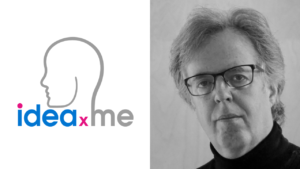
If you liked this interview, be sure to check out our interview with Daniel Birnbaum, Artistic Director, ACUTE Art.
Follow ideaXme on Twitter: @ideaxm
On Instagram: @ideaxme
Find ideaXme across the internet including on iTunes, SoundCloud, Radio Public, TuneIn Radio, I Heart Radio, Google Podcasts, Spotify and more.
ideaXme is a global podcast, creator series and mentor programme. Our mission: Move the human story forward!™ ideaXme Ltd. Our passion: Rich Connectedness.
